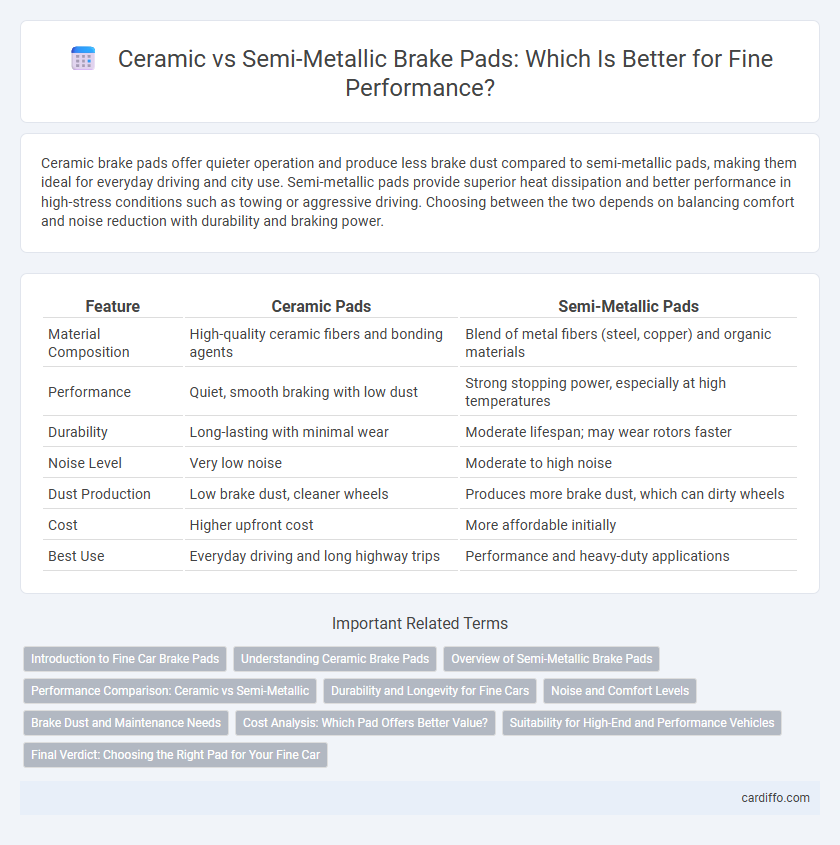Ceramic brake pads offer quieter operation and produce less brake dust compared to semi-metallic pads, making them ideal for everyday driving and city use. Semi-metallic pads provide superior heat dissipation and better performance in high-stress conditions such as towing or aggressive driving. Choosing between the two depends on balancing comfort and noise reduction with durability and braking power.
Table of Comparison
| Feature | Ceramic Pads | Semi-Metallic Pads |
|---|---|---|
| Material Composition | High-quality ceramic fibers and bonding agents | Blend of metal fibers (steel, copper) and organic materials |
| Performance | Quiet, smooth braking with low dust | Strong stopping power, especially at high temperatures |
| Durability | Long-lasting with minimal wear | Moderate lifespan; may wear rotors faster |
| Noise Level | Very low noise | Moderate to high noise |
| Dust Production | Low brake dust, cleaner wheels | Produces more brake dust, which can dirty wheels |
| Cost | Higher upfront cost | More affordable initially |
| Best Use | Everyday driving and long highway trips | Performance and heavy-duty applications |
Introduction to Fine Car Brake Pads
Fine car brake pads offer enhanced stopping power and reduced noise compared to standard options. Ceramic pads feature a smooth, durable composition that minimizes brake dust and wear on rotors, while semi-metallic pads provide superior heat dissipation and effectiveness in extreme conditions. Understanding the differences in material composition and performance helps drivers select the optimal brake pad for safety and longevity.
Understanding Ceramic Brake Pads
Ceramic brake pads offer superior heat dissipation and produce less brake dust compared to semi-metallic pads, enhancing brake system longevity and cleanliness. Their composition includes ceramic fibers and bonding agents, providing quieter operation and reduced wear on rotors. While generally more expensive, ceramic pads deliver consistent performance and are ideal for daily driving conditions requiring smooth and reliable braking.
Overview of Semi-Metallic Brake Pads
Semi-metallic brake pads consist of metal fibers such as steel, iron, or copper, mixed with friction modifiers and fillers, offering enhanced heat dissipation and durability. These pads provide strong braking performance and resistance to wear, making them suitable for high-demand driving conditions and heavy vehicles. Their higher metal content can result in increased noise and brake rotor wear compared to ceramic pads.
Performance Comparison: Ceramic vs Semi-Metallic
Ceramic brake pads deliver consistent stopping power with less noise and dust compared to semi-metallic pads, making them ideal for daily driving and light performance use. Semi-metallic pads excel in heat dissipation and durability, offering superior performance in aggressive driving or heavy-duty applications. The choice hinges on balancing quiet operation and reduced rotor wear (ceramic) against higher friction levels and improved thermal resistance (semi-metallic).
Durability and Longevity for Fine Cars
Ceramic brake pads offer superior durability and longevity for fine cars due to their stable friction material and resistance to heat degradation, ensuring consistent performance over longer periods. Semi-metallic pads provide strong braking power but tend to wear faster and generate more brake dust, which can affect the overall lifespan and cleanliness of premium vehicle wheels. For high-end cars, ceramic pads maintain optimal braking efficiency and reduce maintenance frequency, making them the preferred choice for sustained durability.
Noise and Comfort Levels
Ceramic brake pads generate less noise compared to semi-metallic pads, offering a quieter driving experience due to their denser material composition. They provide superior comfort by reducing vibrations and brake dust, which enhances overall ride quality. Semi-metallic pads tend to be louder and produce more noise during braking, often resulting in a less comfortable driving experience.
Brake Dust and Maintenance Needs
Ceramic brake pads produce significantly less brake dust compared to semi-metallic pads, resulting in cleaner wheels and reduced frequency of wheel cleaning. Semi-metallic pads, containing metal fibers, generate more abrasive dust that accumulates quickly and can lead to increased maintenance efforts. Choosing ceramic pads reduces wear on brake components and minimizes maintenance needs, making them a preferred option for drivers prioritizing cleanliness and longevity.
Cost Analysis: Which Pad Offers Better Value?
Ceramic brake pads typically cost more upfront but offer longer lifespan and quieter performance, reducing replacement frequency and maintenance expenses. Semi-metallic pads are generally less expensive initially but wear out faster and may cause increased rotor wear, leading to higher long-term costs. Evaluating total ownership expenses, ceramic pads provide better value for cost-conscious drivers prioritizing durability and quiet operation.
Suitability for High-End and Performance Vehicles
Ceramic brake pads offer superior performance for high-end vehicles due to their excellent heat dissipation, reduced brake dust, and quieter operation, making them ideal for luxury and performance cars. Semi-metallic pads provide greater durability and enhanced stopping power under extreme conditions, which suits performance vehicles that demand aggressive braking and frequent high-speed use. Choosing between ceramic and semi-metallic brake pads depends on balancing the need for comfort and noise reduction with the requirement for maximum braking performance and longevity in high-performance driving scenarios.
Final Verdict: Choosing the Right Pad for Your Fine Car
Ceramic brake pads offer quieter operation and produce less dust, making them ideal for owners seeking smooth and clean performance for their fine cars. Semi-metallic pads provide superior heat dissipation and increased durability, benefiting drivers who demand aggressive braking and high performance under stress. Selecting the right pad depends on balancing comfort and longevity with braking power and resilience, tailored to the specific driving style and conditions of your fine vehicle.
Ceramic Pads vs Semi-Metallic Pads Infographic

 cardiffo.com
cardiffo.com